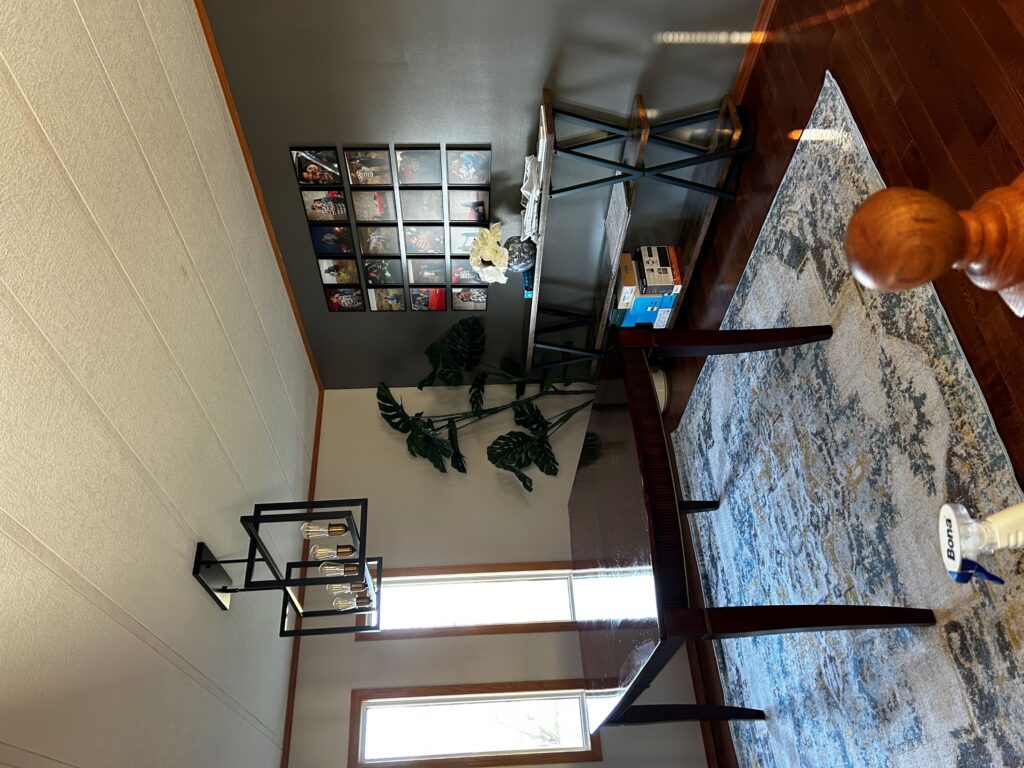Throughout the semester, I contributed to many different blogs and responded to some comments left on my own blog. I didn’t use Discord much; it seems that all of us were mainly able to troubleshoot on our own. Check out my Final Assigned Blog Post Video below showcasing the contributions I’ve made up until now, December 2nd!
Category Archives: EDTC 300
Goodbye Dining Room
If you’ve followed along from the beginning, you’ll know I tackled redesigning my ugly brown dining room for my learning project. Here’s how it started:
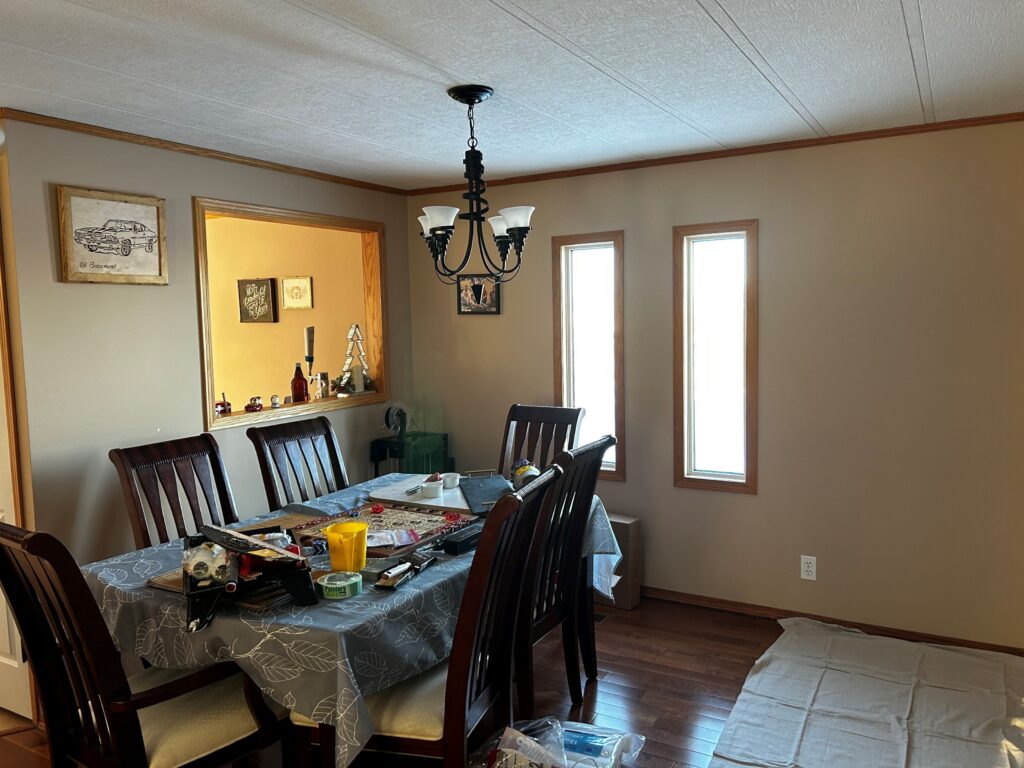
Post 1: He Can’t Say No, Right?
I started by showing you a couple of the projects I had already started in my home and shared my Pinterest Board for home decorating ideas.
Post 2: Anything But Brown
This week I was trying to decide paint colours and used the following resources:
- A blog about choosing paint colours that go with honey oak
- I accessed the Benjamin Moore and Sherwin Williams websites and perused paint colours
- I listened to a podcast on how to choose the right paint colours for your home
- And I also figured out how to create a poll on my blog
Post 3: Let There Be Light
This week I set up a free educators account on Canva in order to create a video. I learned how to save my video from Canva and then upload it to Youtube in order to share on my blog. I needed to watch this video to figure out how to limit my embarrassment so that only people in this class could watch my video.
I then discussed how Canva could be used following the SAMR model.
Post 4: I Did The Dang Thing, Now What?
This week I learned how to add giphs to my blog 🙂
I accessed the following resources:
- Watched this YouTube video on creating a gallery wall
- Checked out the Crate and Barrell website
- Looked at the following Pinterest Board
- Discussed the similarities between Pinterest and Save To Pocket
- And ordered photos from Mixtiles
Post 5: Ordering From Wayfair: Hit Or Miss?
This week I was figuring out all the details on area rugs.
- How to choose an area rug size:
- Wayfair
- Rug and Home
- Stone Gable: Refined Country Living
- Interior Design Tips: No.1 Rule for Dining Room Rug Sizes (this is the video I liked)
- Purchases from:
- I also learned how to use
Post 6: Reality TV Counts As Learning
This week I learned a lot from a TV platform called Tubi where I accessed one of my favourite home design shows called The Block.
I compared this series to some others that I found on Netflix, including Dream Home Makeover and Interior Design Masters.
Post 7: To Buffet, or Not to Buffet?
This week I epically failed at using SketchUp to create a design for my dining room. I resorted back to my failsafes of Pinterest and Wayfair to find inspiration. I also learned how to insert stock images into my blog this week.
Post 8: Using AI to Design My Dining Room
Had some more funny failures this week using AI.
The first thing I did was use Google to search for “AI generator for interior design.” The first website I clicked on was Apartment Therapy, which recommended these programs:
None of these gave me the results I was looking for, and I now get lots of extra junk mail…
Post 9: Add Light, Then Take It Away
I played around a bit more with the formatting on my blog and figured out how to have a picture and text side by side. I had some fun with giphs in this post which I think added a lot of interest. I used some references from Pinterest and showed the purchases I made from Amazon.
And this brings us to the end…
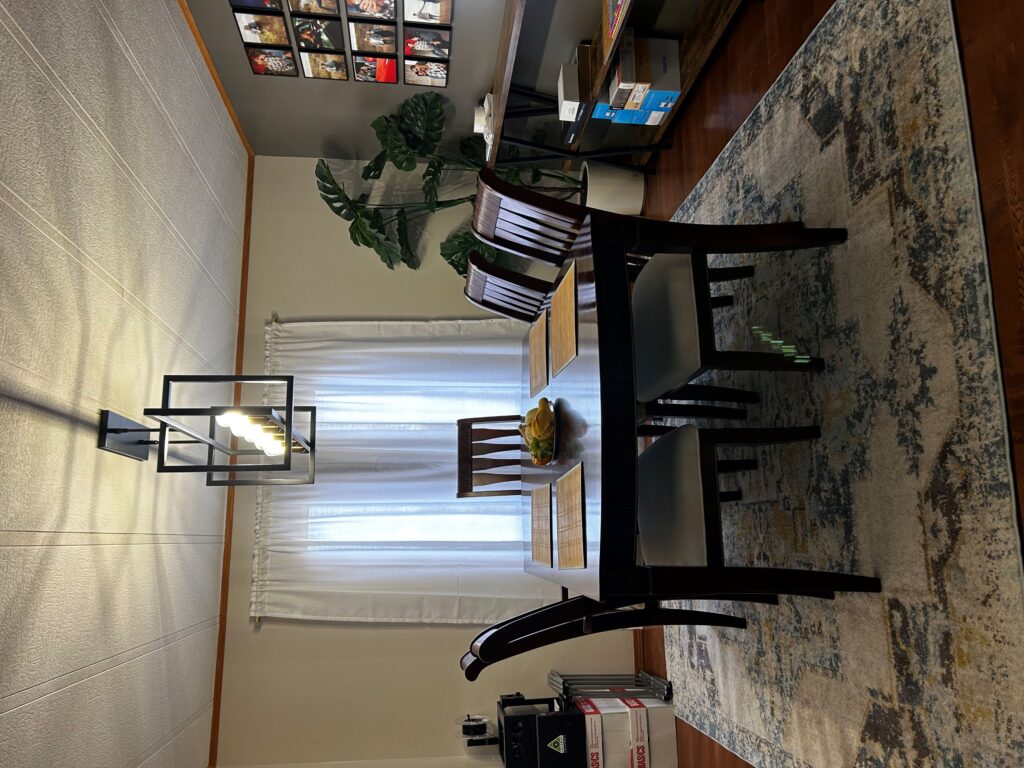
All I really have left to do with this space is tidy up and add Christmas decorations!
I learned about interior design through this project and gained more insight into how I like to learn digitally. For this particular project, I enjoyed more visual resources, like videos, compared to podcasts. Although, I realized that not all videos are created equally. I enjoyed blogging about my progress and finding ways within my blog to add interest and engagement, like using pictures, polls, gifs, videos, links, etc.
I wasn’t exactly sold with the idea of blogging as a way to show my learning, but after finishing this class I think this is actually something I would use with my students.
Thanks, EDTC 300; it’s been a slice!
That’s a Wrap!
Check out my summary of learning below! I’m not sure how you all felt creating your final project, but trying to fit everything we’ve learned into a short video was a real challenge for me. Enjoy!
Where’s the Magic?
As an administrator, I spend a lot of time providing feedback on short and long-term planning; I was very interested in learning more about Magic School and how it might help teachers in lesson/unit planning. I first tried out the unit planning feature and was pretty disappointed. I first tried a 15-day unit plan focusing on Science 7, Outcome IE7.3: Evaluate biogeochemical cycles (water, carbon, and nitrogen) as representations of energy flow and the cycling of matter through ecosystems. The planning was very short and insignificant and did not account for individual needs in the classroom or the adaptive dimension. There was also no mention of the specific outcome or indicators within the lesson.
Look at the first three days of the unit plan; what do you think?
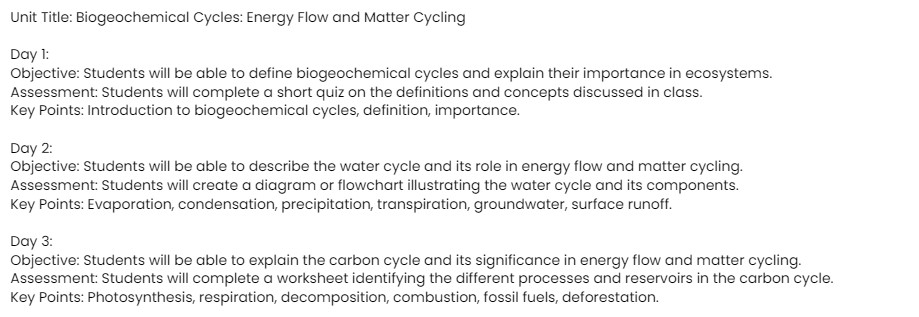
I decided to shorten the timeframe of the unit to 5 days to see if that made a difference in the level of planning.
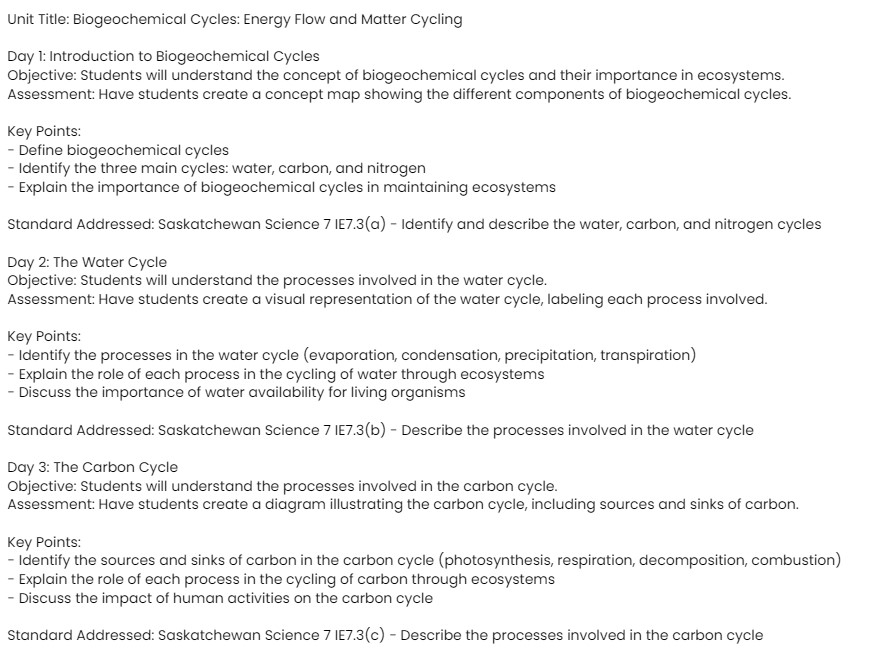
There is a difference in the level of planning this time. Outcomes and indicators are identified this time, and key points of the lesson have been included. However, a significant amount of information is still missing from what I would expect of a unit plan.
This tool would perhaps help create general ideas or a direction in which you might begin planning, but I would never use this tool alone to create a unit plan. What worries me about this tool and its use by new teachers is that they may not realize how much planning is missing. Educators are professionals and should know far better the planning level required in our increasingly complex classrooms. If a new teacher turned this planning in to me, it would warrant discussing their understanding of planning and assessment.
I then tried the lesson plan feature using the same outcome and found it much better.
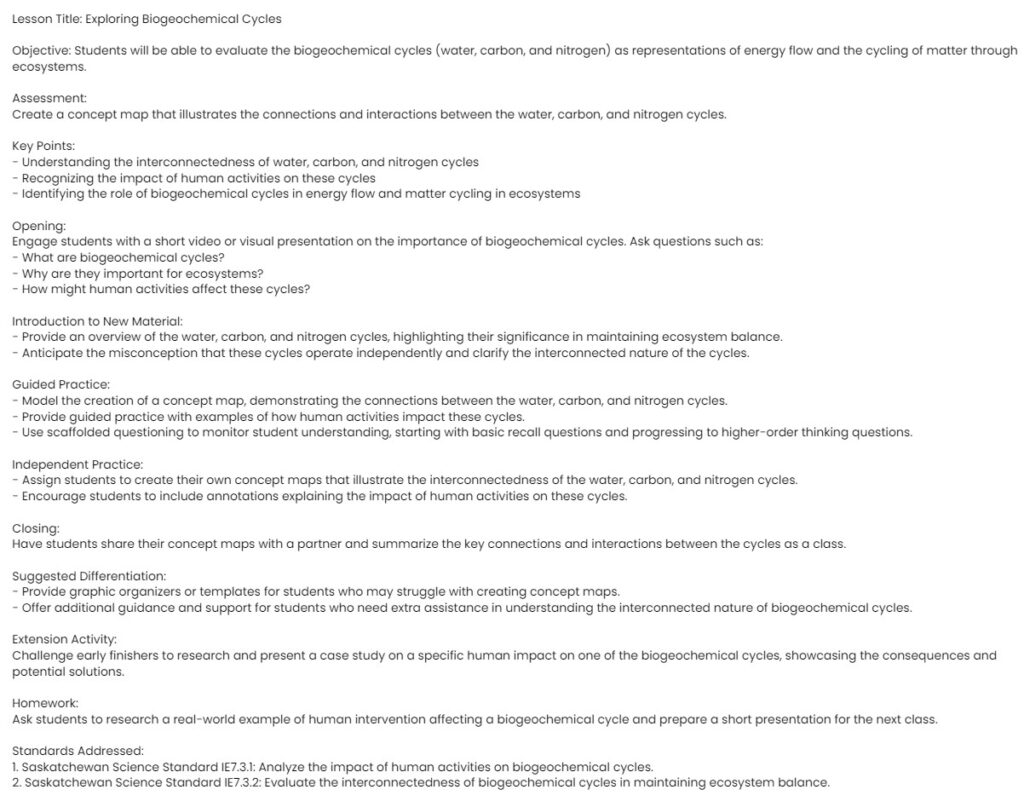
You can see a section for guided practice and suggested differentiation, which is a significant improvement. I do wish there were individually attached lesson plans when you create a unit plan, as these lesson plans, while still lacking in some areas, are a much more robust plan to build off.
I haven’t personally used AI in the classroom yet. I think I can see its value in editing; truthfully, I loved using it to draft emails to parents, give feedback to teachers, etc. I am nervous about introducing it to my students as I don’t think I’m currently prepared to adjust my assignments. As shown in class, there are ways to form prompts that would generate original content and allow for AI editing; however, it would just take time to go through your syllabus and adjust assignments as needed–and it seems that time is something all teachers are lacking right now.
Like it or not, AI is definitely here to stay. Each teacher must work towards learning and identifying their comfort level with its use personally, professionally, and in the classroom.
Who Can We Trust?
Without realizing that this week’s lesson was on Digital Literacy, I watched an episode of Black Mirror titled, “Joan is Awful,” on the plane. The premise of this episode is that when the character, Joan, signed up for Streamberry’s services, where she accepted the terms and conditions without thoroughly reading them (I’m sure we all do this). Within those terms, the company said they might use information gathered about a person and turn them into a TV character, and they had the power to embellish material. Joan, unfortunately, finds herself the target of this.
I always find Black Mirror episodes fascinating because they play on current societal issues and the ‘what ifs’ and what could be… in this case, we give a lot of power to social media and streaming platforms. They collect an incredible amount of data about us, and we don’t really know for sure what information they’re collecting or for what purpose it’s being used for–thinking about it is actually quite scary. This episode also touches on celebrity deepfakes being used against their knowledge, or at least in ways they did not intend to allow. It’s pretty interesting if you want to check it out on Netflix!
We can’t even easily tell on social media who the real trolls are, as evidenced by our class using Spot The Troll, let alone being able to identify our favourite celebrity being used as a deepfake. Here is a crazy example of a Morgan Freeman deepfake that I found from Creative Bloq.
This honestly terrifies me a bit, and reinforces why we desperately need to be teaching our students how to identify fake news. The article, Developing critical literacies: What we need to know in a “fake news” world suggests these tips for students:
- Move beyond traditional – and often ineffective – information evaluation checklists (e.g. RADCAP, CRAAP, and CARS), which fall short when applied to the sophisticated tools and techniques often used to create fake news.
- Prioritize helping students develop investigative techniques where they become familiar with information verification websites (e.g. FactsCan, org, Snopes, and Hoax Slayer) and tools like Google’s “search by image” feature or the VerificationHandbook.com resource. Students can also learn about professional fact checking strategies such as reading laterally, which involves cross-referencing a variety of websites rather than digging further into the website at hand.
- Teach students to identify bias using tools like a media bias chart, which provides a starting point for them to understand that all sources come from a particular perspective.
- Bring real-world fake news examples that we encounter everyday into the classroom so that students can be challenged to apply their skills and techniques to authentic situations, like determining the true origin of a viral image or video and examining potential catfishers, bots, or trolls in order to better understand the hallmarks of fake and malicious social media accounts.
While these are great, a tremendous amount of onus is put on our students/children to check everything they consume. This can quickly become an overwhelming and very daunting task. To add to this, I read, You’re not going to believe what I’m about to tell you where I learned about the ‘backfire effect’ (I even double-checked this term for its validity because I learned about it from The Oatmeal). Essentially, we want to believe in the things that do not question our core values, and the things that do question those beliefs send our brains into attack/threat mode. The way that algorithms work on social media, we only see the things that fuel and feed our pre-existing beliefs, or those that are easily added to our beliefs. If we see information that confronts those beliefs, we double down on what we ‘know’ and it doesn’t matter the amount of evidence you can produce (it actually even makes it worse), their mind is not going to be changed.
How, as educators, can we possibly combat this? And who are we to decide at this point what the ‘truth’ is? Sigh. My brain hurts.
Add Light, Then Take It Away
My dining room has two weird windows, and while they provide beautiful natural light, they aren’t all that aesthetically pleasing. While the dining room is coming together well, there are a few missing pieces, including curtains!

Truthfully, I grew up in an old farmhouse, and most of the curtains in my house looked like these. If you’ve seen The Sound Of Music, you’ll know that these looked much better as matching outfits on the kids than they ever did as curtains.

The other option in our house was blinds…and not cute ones. I knew I wanted to filter some of the sunlight in our home, but I was pretty nervous about making the room look dated.
I wanted to add as much height as possible because our dining room isn’t huge, and the ceilings aren’t very tall. I wanted to play around with colour and pattern, maybe… but the idea of having a Sound of Music moment where my curtains would be better off as costumes makes me cringe.
I started by looking on Pinterest, which continues to be a fantastic go-to for all things related to design in my home. This is a helpful resource I came across.

“Curtain Tips by dominomag.com.” Pinterest.com, 26 Nov, 2023.https://pin.it/4uRDdw9
Based on the above graphic, I knew I wanted a ‘lived-in’ style and for my ceilings to soar. While custom curtains would have been amazing, they aren’t in the budget. Has anyone done custom curtains/blinds? We did custom light filtering shades in our bathroom and office, and wowza–they are an investment! I wasn’t looking at having any investment pieces in our dining room because we’re hoping to have a family, and I know any curtains I choose will likely be covered in food at some point.
I took some measurements and knew that I should be shopping for 84″ curtains in a set with two panels. Our dining room is also across from our living room, which oddly does not have its own light source (a bizarre design choice in a lot of houses from the 80s). Therefore, I felt I needed to choose a sheer curtain to keep as much natural light in the house as possible. Also, after discussing the possibility of a patterned or coloured curtain with my husband I decided to go with a solid colour; the poor guy is still getting used to the colour on the rug…and the walls.
So, here’s what I bought from Amazon:

I think it’s fair that I chose the most neutral option. The only colour that I really played with is that the curtain rod is gold to play off the gold paint on the light fixture and the curtains themselves have a bit of a sheen to them–but, my husband is happy. I do that they add a lot of height to the room and help to balance the space better. I still need to steam them, but then I think aside from decorating my shelf this space is pretty much done!
If I had gone with a different sheer colour, which one would you have chosen?
Poem Art
I tried a lesson on Poem Art on An Hour of Code tonight. I was skeptical about how this would relate to anything I would do in a senior ELA class. However, this was an enjoyable and educational way to incorporate computer science and a lesson on mood in poetry.
I first learned about choosing a background colour and text effect that suited the mood of a poem. Below, I chose a yellow background and a typewriter sound effect. I thought this was a great introduction to visually representing mood.

Next, I focused on what sounds and images came to mind as I read a poem. I wrote, “A robin sitting in a nest singing proudly.” The bird song came through well in the animation; however, there was no image of a robin or nest. I found this particular lesson to be a bit of a dud even though its intention was great.

Next, I learned that the mood can change in poetry, so there was a lesson on coding line by line of a poem. Here, you can see that I have coded, “when line 1 appears, do rain effect,” and “when line 2 appears, set background to green,” etc. It was awesome to have the flexibility to show a deeper understanding of the poem.

Then, I learned about how to add and move sprites around my poem. You can see that my coding is becoming more complex and that I am using the tools I learned in previous lessons.


Overall, I enjoyed My Hour of Code and the lesson on Poem Art. I would use this program in one of my middle years ELA classes. This lesson is definitely an introductory lesson regarding the information it provides about mood, but it is still a helpful tool that I think would create a lot of student buy-in. In my current school setting (A Hutterite Colony), coding is not a skill that is important to teach; however, I see its value in other classrooms, especially with our government’s move to eliminate some previous core classes to make room for more electives. Our world and the needs of our students are constantly changing, and although change is hard, it is our job to adapt and do what is necessary for students to be successful in school and beyond.

Here’s a link if you’d like to check out my final poem art project!
Using AI to Design My Dining Room
After struggling a couple of weeks ago to use Sketchup and wanting to use technology to ‘see’ what my dining room could look like, I decided that this week I wanted to see what was out there for free AI programs.
The first thing I did was use Google to search for “AI generator for interior design.” The first website I clicked on was Apartment Therapy, which recommended these programs:
I tried out RoomsGPT first and created a free account. I chose a picture of my dining room, chose ‘modern’ for style, and this is how it turned out:
Not exactly a success. I tried to create other styles with the same photo, but I continually got an error code saying it could not generate anything. I’m unsure if this was a glitch in the website or something to do with my internet. Regardless, this wasn’t exactly what I had in mind–although it’s a neat thing to play with if it works.
Next up, I tried Microsoft Bing Image Creator. This was definitely a letdown. The program runs on ‘credits,’ so you can’t go crazy with what you try. It also relies on your description of a room to generate a photo, and I believe it failed miserably. I provided the program with the following description, “dining room with 8×8 carpet and a dark grey accent wall in a modern farmhouse style,” and here is what it created:

Again, I wouldn’t say that this image was a success. It is also hard to replicate specific features of my dining room. I’m sure I could hone this image some more if I had unlimited credits, but it was more work than I had anticipated.
This is where I stopped. Creating free accounts that then bombard my email with junk isn’t all that appealing. Out of the two programs that I tried, I would say RoomsGPT was more successful, but still not something I would try again.
Have you tried any of the other programs I mentioned? Or one that wasn’t listed here?
To Buffet, or Not to Buffet?
This week has been hard trying to get back into the creative swing of things. For anyone in the classroom, you know it’s a busy time of the year trying to get ready for report cards, and in general, it just seems like teachers are feeling more burnt out than usual–I’d definitely say this is true for myself.
So, while this post isn’t super creative in how I will show you my learning, hopefully, you can take something away from it.
Recently, I’ve been seeing a lot of ads for Sketchup on my social media, and it looked like an exciting design tool, so I thought I’d check it out. Holy cow, it is probably the most frustrating program I have ever tried to use. I would have made a video of me trying to use it, but after an hour, I had literally done nothing. Sketchup is a 3D design software program, and there is a version that is free for educators to use. I was using the online version, where this video seems to show that there is maybe a downloadable version. Regardless, after an hour, I was left with nothing even remotely close to this. Perhaps you will have better luck. If you can get this program to work for you, there are lots of tutorials on the website itself, linked here.
I was trying to use this program to see how big I wanted a buffet or shelf to be underneath my galley wall. Since it didn’t work, I just started looking at dining rooms on Pinterest and scrolling through Wayfair. I really love the look of a traditional buffet, but I was unsure if it would make our small dining room look too full.

Absolutely love the look of this, but there is already so much wood in our house that I was afraid it would be too much.
Instead, I opted for an open shelf where we can display some of the trinkets and art that we’ve purchased on our travels. I bought it from Wayfair, and I really like it. I think the struggle now will be to tastefully decorate it and not let it fill up with junk.
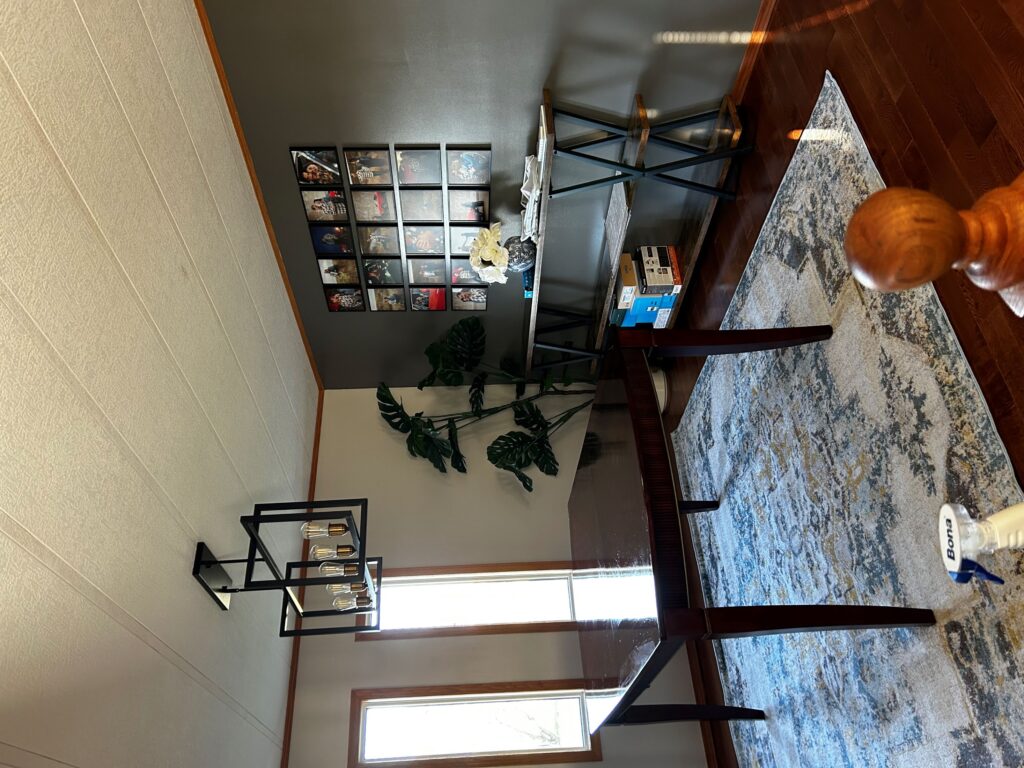
I’m mostly pumped that it’s so close to the Christmas season, and I can soon start to fill this bad boy up with many, many new decorations.

Are there any other Christmas fanatics out there?
Reality TV Counts As Learning
This has been a tough week for me. A lot was happening, both professionally and personally, and unfortunately, it was not all good. Tackling a really cool new way to show my learning just wasn’t a priority. However, I could sit down in the evenings and watch some shows on interior design–my favourite. I think these types of shows are great ways to become inspired and to help identify your own style, often by learning what you don’t like.
My all-time favourite show is The Block; I watch the one based in Australia. I watched this in university, and then when I was in Bali–because it’s so close to Australia, I would see advertisements for it. When I got home, I made it my mission to find and start watching it again. I found it on Tubi; however, there were only two older seasons.
Here is the trailer for season 16, which I haven’t seen but would love to! What I like about this show is that most couples who compete aren’t professionals, and so you get to see them struggle through renovations and designing–much like I do. They are also always tasked with unique design challenges, which I love because I see more styles. The show is also cheesy and has some drama–can it get any better!?
In comparison, I have watched Dream Home Makeover on Netflix, and while it’s still entertaining, I find it a bit boring because it’s always the same style over and over. Plus, there are never any complete fails/flops because they are professionals. Check out the trailer below.
Another fun show that I love–and am now realizing I really love seeing everyday people tackle design is Interior Design Masters with Alan Carr, who is hilarious. Again, because this is an interior design competition, you get to see lots of different styles being tried out, some successful and others not so much. This one can also be found on Netflix.
While I didn’t make any progress on my actual dining room this week, I am feeling a little more refreshed and inspired to continue working on it.
Do you have a favourite interior design show?

